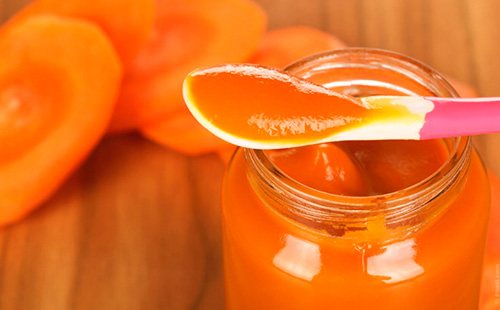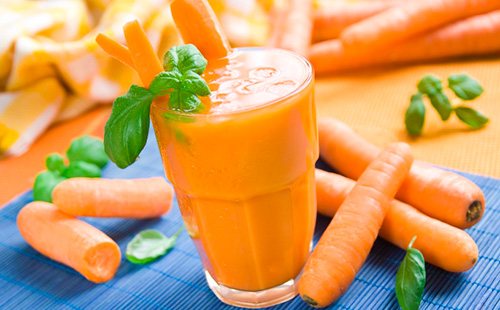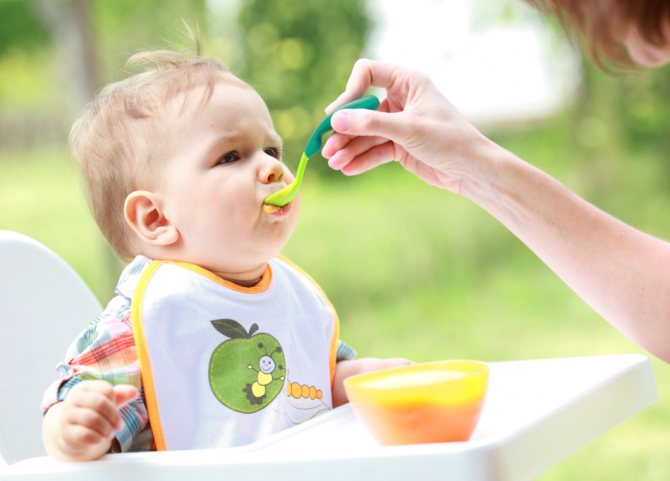The benefits and harms of carrots in children's nutrition
Carrots contain a large amount of water, they are rich in vitamins (A, C, B1, B2, PP, E, folic acid), and also contain potassium, sodium, copper, calcium, phosphorus, zinc, iron, magnesium, iodine and other valuable microelements.
Carrots are useful for children because:
- strengthens bone tissue and teeth;
- has a positive effect on the functioning of the heart;
- improves blood circulation;
- stimulates the digestive system;
- helps strengthen the immune system;
- has a beneficial effect on vision;
- reduces the risk of developing cancer;
- promotes the regeneration of liver and kidney cells;
- helps cleanse the body of harmful substances;
- improves skin condition;
- Gives a boost of energy while being a low-calorie product.
The sooner this vegetable appears in the diet, the better. Therefore, carrots can and even should be included in complementary foods for children under one year of age.
How can carrots be harmful?
This vegetable quite often causes allergies in children due to its bright orange color. The reaction usually manifests itself quickly and, as a rule, there is rarely any doubt as to what exactly it occurred.
Also, frequent consumption of carrots can often lead to carotene jaundice, when a yellow tint appears on the skin (mainly on the palms and soles).
Know!
This condition in itself is safe. But accompanying symptoms may also occur: nausea, vomiting, sleep disturbance. In this case, carrots should be excluded from the child’s diet for some time.
Useful properties of carrots
Since ancient times, people have used carrots as a medicinal plant, and only then as a vegetable for cooking. Carrots contain:
- Sodium. This microelement plays an important role in water-salt metabolism in the body and supports the functionality of the nervous system.
- Potassium. Responsible in the body for the proper functioning of blood vessels, capillaries, and muscles. This is especially true for the heart muscle.
- Phosphorus actively participates in the formation of bone tissue and promotes the absorption of vitamins.
- Calcium is one of the most important elements for the formation of bones and teeth.
- Magnesium controls the flow of all vital processes in the body. A deficiency of this microelement can lead to metabolic disorders.
- Iron takes an active part in the process of hematopoiesis, in the formation of hemoglobin.
- Iodine in the body is responsible for proper metabolism.
All of the above microelements must be present in the diet of a baby who is actively growing and developing. To provide the necessary set of vitamins and microelements, breast milk alone is no longer enough, so carrot puree will be an excellent complementary food for infants.
Probably every schoolchild knows that this orange vegetable contains such a useful substance as carotene. This provitamin takes an active part in bone growth and strengthening the immune system. The health of teeth, gums, hair and skin directly depends on the presence of a sufficient amount of carotene in the body. Therefore, infants, for whom the process of growth and bone formation is almost in first place in importance, must receive carrot puree without fail.
At what age can children be given carrots?
In the question of how many months a child can eat carrots, the complementary feeding system that parents follow when expanding the baby’s diet plays an important role.
- In natural (pedagogical) complementary feeding there is no specific sequence of products that the child is gradually introduced to. He can be given any food (within reasonable limits, of course) that adults eat, but in microdoses;
Therefore, according to this system, carrots can be offered to infants immediately when complementary foods are introduced, but in a very small volume, for example, 1-2 microdoses.
Remember!
And, of course, it is important to control his body’s reaction, as when introducing him to any new product.
- In the pediatric complementary feeding system, it is recommended to introduce carrots into the child’s diet after he has become acquainted with hypoallergenic vegetables (zucchini, cauliflower, broccoli).
What is more important is how ready the child’s body is for this vegetable:
- For example, if the baby responds well to previously introduced foods, then there is no need to delay introducing carrots;
- But if he was initially diagnosed with an allergy (to his mother’s food or to the first vegetables he had already tried), then there is a high probability that the reaction to carrots will be similar.
In this case, you can take your time introducing it into complementary foods.
The standard rule applies to how much carrots a child can be given:
- We start with a minimum volume: with a couple of microdoses or ½ teaspoon in the first half of the day;
- In the absence of a negative reaction, the amount of product gradually increases every day, but very smoothly;
- The maximum amount of carrots that can be given to a child per day is 30 g (this is the total amount of the vegetable in any form: raw, pureed or as part of other dishes).
You will find more information about how to properly introduce complementary foods to an infant, the sequence and volumes of introducing foods so that the child eats with pleasure and without difficulties, in the online course ABC of complementary feeding: safe introduction of complementary foods to an infant >>>
Important!
For better absorption of beta-carotene contained in carrots, it should be consumed in combination with vegetable oil.
- For children under one year old, carrots can be given boiled or pureed;
The carrots should be soft and boiled. Sometimes you can use jarred carrot puree, which is available in almost any store in the baby food section.
- It is better to give a whole raw vegetable to a child after 1-1.5 years, when he already has a sufficient number of teeth;
Before this age, you can offer to chew carrots when the baby is teething, but be careful that he does not bite off pieces of the vegetable, otherwise he may choke.
- A child from 1 year old can be given grated carrots. It should not be done earlier, because, due to its rough structure, it is poorly digested by babies (read the article
The development of infants depends on proper nutrition and care. Loving parents are interested in when and how to introduce carrots into complementary foods in order to benefit them and avoid allergies. And this is not idle interest, but a priority approach to gradually transfer the baby to a baby diet from breastfeeding. Carrots are known for their beneficial properties and vitamin content, but they are introduced into complementary foods gradually, in different forms.
Recipe 4: Carrot puree with beets and cauliflower
This dish will turn out to be a bright, appetizing color with an equally strong aroma and taste.
Required ingredients:
- Carrots 2 pieces
- Cauliflower 300 grams
- Beetroot 2 pieces
- Cream 200 grams (15% fat)
- Seasonings
- Hard cheese
Cooking method:
- Wash the cauliflower thoroughly and separate it into florets with your hands. Boil it in a pan filled with water for fifteen minutes.
- Thoroughly wash the carrots and beets from the soil and boil these vegetables in a saucepan. The carrots will be ready in thirty minutes, and the beets in fifty.
- Place the cabbage, carrots and beets in a blender and start blending, gradually adding cream to the vegetables.
- Grate the hard cheese and sprinkle it over the finished carrot puree and vegetables.
- Carrots will be equally useful regardless of whether they are steamed or boiled.
- If you are making sweet puree, then carrots go very well with plums, apricots, and pears. Remember that carrots contain sugar, so you don’t have to add any additional sugar to the finished dish; the puree will already be quite sweet.
- Serve the finished puree, seasoning it with sour cream - this will improve the taste, and the beneficial substances of carrots will be more actively absorbed by the body.
- If you want to use your own carrot juice when making puree, then prepare the carrots as follows: place the peeled and washed vegetable in a saucepan greased with oil and fill it with water to the top. Simmer the carrots for about 30 minutes, turning the vegetable over and adding water from time to time. Add the resulting juice to the puree when grinding.
A very important product. Follow our simple step-by-step instructions to learn how to introduce carrots into complementary foods and how to make carrot puree for your baby.
However, from 7-8 months you can try giving a little carrot puree to your baby. Do not forget about how to introduce complementary foods: start with a small dose (half a teaspoon of carrot puree is enough) in the morning meal, so that during the day you can monitor whether the child has an allergic reaction. If tolerated normally, gradually increase the dose.
Carrots for babies: benefit or harm
Carrots are an all-season vegetable, a treasure trove of vitamins and nutrients involved in the creation of a growing organism. Beta-carotene (provitamin A) promotes cell division and tissue growth, including the formation of teeth and skeleton, hematopoietic system, liver and kidneys. It is an antioxidant that helps strengthen the immune system in the fight against pathogenic microflora.
Substances present in healthy vegetables (calcium, potassium, sodium and phosphorus, vitamins A, B, C, E, folic acid) shorten the recovery period after viral diseases. Dietary fiber, which carrots are rich in, is necessary for the functioning of the digestive tract and intestinal motility during the transition from breast milk to a full-fledged diet.
Provitamin A in sufficient quantities means healthy skin, sharp vision and normal condition of the baby’s mucous membranes. Its deficiency is symptomatically manifested in the form of insufficient height and body weight, dry skin and mucous membranes. Weak immunity – frequent “childhood diseases”.
If this complementary food is introduced incorrectly, it can have negative consequences:
- allergy to orange vegetable (rash, slight fever);
- “carotene jaundice” (yellowness of the palms, feet and sclera of the eyes);
- The baby’s body is not ready to digest carrots (nausea and vomiting, restless sleep, slight diarrhea).
It is important to monitor the introduction of any complementary foods, and when introducing a new product for the first time, give it in minimal doses. Overfeeding carrots can harm the liver. Although there are general recommendations for the timing of introducing each type of complementary food, each child has his own individual reaction to each juice, puree or new raw product.
All these appearances may not happen, but the benefits of the product are obvious. Companies that produce baby food note that among the first complementary foods, the most popular vegetables remain zucchini, carrots, broccoli and cauliflower. Any juice or puree for the first complementary feeding can be bought ready-made or made according to all the rules yourself.
Recipes with carrots for babies
Carrot puree for complementary feeding
Take two carrots, rinse and peel. Leave in cool to cold water for two hours, then cook until tender. The finished vegetable is peeled from the core and chopped, then passed through a blender or rubbed using a sieve. Breast milk, formula or boiled water are added to the prepared puree; you can also add butter or vegetable oil or sour cream. You can also cook vegetables in a double boiler or slow cooker, or in a water bath. For babies after a year, the puree can be salted.
Carrot juice for babies
After the mother has introduced vegetable puree from carrots into complementary foods, carrot juice can be included in the diet after one or two weeks. To prepare the drink, carrots are washed, peeled and passed through a juicer. The juice is filtered and diluted halfway with boiled water. The first drinks must be diluted! Gradually the amount of water is reduced, and the juice itself is increased until they completely switch to natural juice. A baby under one year old should not be given juice with pulp and it is not recommended to put sugar in the drink.
Vegetable puree soup
- Zucchini – 1 medium fruit;
- Cauliflower and broccoli – 250 grams each;
- Tomatoes – 2 fruits;
- Carrots – 1⁄2 pcs.;
- Chopped fresh herbs to taste.
Grate the washed and peeled vegetables. Simmer over low heat for three minutes and add to boiling water (1.5 liters). If necessary, add salt and pepper, add herbs and cook for ten minutes. Beat the prepared vegetables with a blender and grind through cheesecloth or a sieve. Then the puree soup will be airy and light. If the consistency is too thick, dilute the dish with vegetable broth that remains after cooking.
Suitable age for infants to enter
Young mothers often ask pediatricians at what month to start feeding carrots, since this is a specific root vegetable. Opinions differ; recommendations on jars of baby food (from different companies) with complementary foods for infants also indicate different ages.
Experts offer a proven scheme:
- h 4 months (a few drops with mixtures for artificial babies);
- from 5-6 months, a little juice as complementary food (after the main meal);
- at 7-12 months, carrot puree as a separate complementary food and as an additive to soup and other vegetables;
- From 1 year of age carrot salad is prepared.
Giving up carrots does not mean not giving any supplements during this period. Instead of carrots, they give other juices and purees, check which ones with your doctor. It is possible to find out whether there is an allergy to carrots only after tests and monitoring the general condition of the baby. If the baby has enough mother's milk and is prone to allergies, then you can take your time with carrot juice and puree until 7-8 months. A natural product for babies, it provides all the necessary substances that help strengthen the immune system.
Sooner or later, breast milk will dry up and the baby will switch to solid food. It is advisable that he begins to become familiar with the taste of other foods no later than from the age of six months. And the young mother will have to master a simple children's kitchen according to all the rules.
It is difficult to predict whether your baby or toddler will like the taste of carrot juice or puree. For juice, it is better to choose a sweet root vegetable with a weakly expressed color. The puree is made from carrots with a neutral taste. The baby's reaction to the taste of carrot puree can be seen from the introduction to the new product on the tip of a teaspoon. If you don’t like it, it’s better to postpone the second try for a few days until the baby forgets the strange taste.
If you have a negative reaction to the taste, it is better to mix carrot juice or puree with another complementary food that you prefer, for example, apple juice, cottage cheese or quince puree. You can start giving juice with half a teaspoon; for people with allergies – with a few drops.
Provitamin A is absorbed in combination with fats, so add a little breast milk or a little olive (corn) oil to carrot juice.
Carrot menu for babies: recipes for children's dishes
So that the benefits of the orange vegetable do not pale before the harm, it is important to prepare it correctly. As a first carrot dish, you can offer your baby carrot puree.
Industrial puree, store-bought
When buying jars of baby food in a store, carefully consider the packaging:
- Has the expiration date expired?
- Is the lid on the puree package bulging?
- Does it contain preservatives, salt, sugar?
The unopened package can be stored at home in a dark place at room temperature or in the refrigerator. When opening the jar, you should hear a pop, which indicates that the seal is not broken. The first portions of complementary foods are minimal; the baby will not be able to finish the whole jar. Therefore, after opening the package, place a single serving in another bowl, close the jar tightly with a lid and put it in the refrigerator. Before giving the puree to your child, heat it in a water bath to a temperature of 36-37 degrees.

Mamino puree, homemade
Making carrot puree for babies is not at all difficult at home.
- Take 100 g of carrots, 25 ml of milk and 3 g of vegetable oil (it will soften the puree and help preserve an important vitamin necessary for visual acuity, growth and skin). Ideal for baby food, of course, would be a vegetable grown without chemicals on its own plot. If you doubt the origin of the red beauty, you can soak it in water for several hours.
- Wash the carrots thoroughly, preferably with a brush, peel and cut into cubes or small pieces (you can cut into strips or chop on a coarse grater).
- Pour boiling water over the resulting mass so that the water completely covers it.
- Place the pan on the stove and simmer until tender over low heat.
- Drain the remaining liquid or place the boiled carrots in a colander, and then puree with a blender or rub through a sieve, getting rid of lumps.
- Add heated milk to the resulting carrot mass, a little salt (optional) and bring to a boil. Add a couple of drops of vegetable oil and cool.

Vegetable puree from cauliflower and carrots
- You will need 1 carrot, 150 g cauliflower, 1.5 cups of water, 1 tsp. sunflower, olive or corn oil, salt.
- Wash the root vegetable properly using a brush, clean it, cut it into small pieces and place it in a pan with boiling water.
- After 10 minutes, add the washed cabbage, disassembled into inflorescences. Cook for another 5-7 minutes.
- Cool, puree using a blender or rub through a sieve.
- Add vegetable oil to the resulting puree and add a little salt. Since the baby is not addicted to salty foods, you can completely do without salt. Puree will be even healthier.

carrot juice
- We clean the thoroughly washed carrots and scald them with boiling water.
- Grind on a fine grater and, using sterile gauze folded in several layers, squeeze out the juice by hand. You can use a juicer. True, the metal elements oxidize, and some of the carrot benefits are lost.
- The finished juice must be diluted with water before giving it to the baby. Store in the refrigerator for no more than a day.
How to make your baby's first carrot juice
A successful trial with carrot complementary foods does not mean that it should be given often. Excessive treats may result in excess vitamin A or hypervitaminosis. Two or three times a week is quite enough. Carrot juice should be freshly squeezed from a juicy root vegetable.
Before preparing carrot juice for babies, it is recommended to soak the sweet root for 1-2 hours in water at room temperature. Before cooking, it is better to scald with boiling water to prevent pathogenic microflora that could be in the ground from getting into the juice.
Cleanly washed carrots are grated on a fine grater. Place the resulting pulp on the finest strainer and squeeze out the juice. You can use 2-3 layers of gauze to completely separate the fibers from the juice. For the first complementary foods at 5 months, it is diluted in half with boiled water.
To improve the taste, carrot juice can be mixed with apple juice. When the baby gets used to carrot and apple-carrot juice, you can gradually introduce other mixes into the diet, but only those recommended for babies under one year old. You should not use allergenic vegetables and fruits in your vitamin “cocktail,” no matter how healthy they may be.
How to cook carrots for babies
Peel the carrots, be sure to cut off the top and tail. After cleaning, the vegetable can be left for 1.5-2 hours in cool water to remove nitrates, pesticides and other harmful substances. If these are natural carrots grown on your own plot without adding chemicals, the vegetables do not have to be left in water.
After preparation, the vegetable is cooked until tender and passed through a blender or sieve. You can give carrot puree to your baby mixed with breast milk, boiled water or ready-made formula; also add two or three drops of vegetable oil or a teaspoon of low-fat sour cream for taste.
To prepare soups, carrots can be grated; for babies older than 9-12 months, the vegetable can first be lightly fried in vegetable oil. For children under one year old, it is not recommended to add salt and pepper to the dish, or add onions and garlic. Hot spices and seasonings, mayonnaise and various sauces are strictly prohibited in infancy and for older children.
It is better to eat the finished puree immediately; in extreme cases, you can store the dish in the refrigerator for no more than 24 hours. In this case, the puree should be closed in a container with a tight lid. To warm up your baby's food, use a water bath or simply leave the puree at room temperature. Do not heat food in the microwave or in a frying pan!
The broth that remains after cooking carrots and other vegetables must be drained. This decoction negatively affects the baby’s digestion, kidney and liver function. Meat, fish and vegetable broths are not recommended for children under three years of age. Read what else you should not give to children under three years of age.
How to make carrot puree for your baby
There is nothing difficult in preparing carrot puree for infants, but young mothers often buy ready-made in jars in baby food departments. Perhaps the “branded” fortified one, as indicated in the instructions, is made according to all the rules. But there is nothing better than a fresh product prepared by mother’s caring hands.
Carrot puree is well absorbed by the child's body; most kids like its sweetish taste. If the child frowns and is reluctant to eat this complementary food, you can flavor it a little.
Don’t rush to introduce your baby or toddler to sweet foods. He should accept purees, cereals and soups based on environmentally friendly products with a natural taste well.
The puree is made from boiled carrots. To prepare, you need medium-sized, sweet, strong carrots grown in garden conditions without chemicals. They wash it well, clean it, cut it into rings so that it is ready faster. You can also cook the whole one until softened over low heat in order to preserve the beneficial properties as much as possible.
Rub the cooled boiled carrots through a sieve or chop with a blender. For better absorption and adaptation of taste, add a little breast milk or powdered infant formula to the finished puree. A couple of drops of olive oil promotes better absorption of beta-carotene. If the puree turns out thick, it is diluted with milk or boiled water.
Some nutritionists and pediatricians do not recommend using the core of the root vegetable for baby purees, especially if the conditions for its cultivation are not known. It is believed that excess nitrates accumulate in this part of the healthy vegetable. Perhaps it is precisely these carrots, cultivated with fertilizers, that are the most allergenic.
Mashed potatoes for complementary feeding begin to be given in small portions. For the first time, a little chopped carrot on the tip of a teaspoon is enough. If your baby likes it, use this vitamin supplement, half a teaspoon, 2 times a week, if there are no allergies. If a child is capricious and does not perceive the taste of boiled root vegetables. The taste of carrot puree can be improved by adding grated apple or an adapted milk mixture.
Carrot dishes
For children who tolerate cow's milk well, you can prepare puree soup. To do this, carrots must be washed, peeled and cut into pieces. Pour milk into a small saucepan and bring it to a boil. Add carrots there and cook until soft. Then beat with a blender.
Many kids will love sweet carrot pancakes. For them you will need: carrots, apple, dried fruits, milk, egg, rolled oats, butter.
- Pour boiling water over the dried fruits and let them soak.
- Peel and grate the apple.
- Grate the carrots on a fine grater and put them in a saucepan to simmer.
- Chop the dried fruits and send them to simmer together with the apple in another pan.
- Grind the Hercules in a coffee grinder.
- When everything is ready, mix the root vegetable with milk, egg and rolled oats.
- The mass should be quite plastic. Form it into thick pancakes and put a sweet fruit filling in the middle. Seal them and form pancakes again.
- Fry in butter on both sides.
- Cooked pancakes are best served with sour cream.
Another sweet dish would be cottage cheese and carrot casserole. To do this, you need to grate the carrots on a fine grater and simmer until half cooked. Rub the cottage cheese through a sieve and mix with the egg, butter, sour cream and small cereals (semolina or crushed oatmeal). Then add the prepared carrots and grated apple. How to cook: place the mixture in a deep baking tray or frying pan and bake for 30-40 minutes.
Carrot juice is essential for complementary feeding. Although most doctors are against juices in general, some types are allowed. Including from this vegetable. To prepare it you need a juicer. Then it should be strained so that no pieces of pulp remain. For a more pleasant taste, you can add a little sugar. Despite the fact that juice is very healthy, its quantity is limited - no more than 0.5 glasses per day.
Meat and carrot cutlets will also be very useful. Grind the chicken fillet in a meat grinder. Boil the carrots until half cooked and grate them on a fine grater. Mix the minced meat with the root vegetable, add the egg and soaked oatmeal. Form cutlets and steam.
Most children love to chew on this sweet orange vegetable. But even here you should limit the number of carrots you eat. It is worth doing this because it is difficult to digest in the body. And an excess of nutrients is not good - hypervitaminosis is possible. But the first complementary food should only be boiled. You can start feeding it raw closer to the age of one year.
| calories, kcal/100 g | proteins, g | fats, g | carbohydrates, g | |
| raw | 32 | 1,3 | 0,1 | 6,9 |
| stewed | 30 | 1,0 | 0,2 | 6,3 |
| boiled | 25 | 0,8 | 0,3 | 5,8 |
How to make carrot salad for your baby
It is better not to rush with your first treat of coarse carrot fibers. Complementary food made from grated carrots is offered to a one-year-old child, regardless of whether his main diet is based on breast milk or artificial nutrition. Season finely grated carrots with low-fat sour cream or “live” yogurt. Salad is used as a side dish and as a main breakfast or afternoon snack.
For any type of carrot feeding, choose only juicy root vegetables without damage, mold or wormholes. When cooking and cooking, young mothers try to use salt, sugar or honey to improve the taste. But they are harmful to the baby, and the taste of complementary foods should be natural.
In order for the baby to develop and grow normally and correctly, he must receive high-quality and healthy nutrition. Of course, breast milk is the most valuable and best thing that a loving mother can offer her child. Over time, other healthy foods will help supplement your baby’s milk diet. And one of them is carrots. The main thing is to know how to introduce carrots into complementary foods so that it brings benefits to his health.
Benefits and harms for the child
Even our grandmothers and great-grandmothers knew about the beneficial effect of carrots on a baby’s growth. From the point of view of modern medicine and dietetics, this value of the orange root vegetable can be explained as follows:
- due to the increased content of carotene, carrots promote the synthesis of vitamin A - the most famous and powerful growth vitamin;
- this vegetable is good for the baby’s digestive system because it contains fiber and coarse fibers;
- contains a whole scattering of useful vitamins and microelements, for example, A, E, C, K, almost all vitamins from group B, folic acid;
- Beta-carotene is essential for vision. This substance also enhances the protective functions of the child’s body. With regular and proper consumption of carrots, your child will not be afraid of colds. This vegetable replaces dozens of immunomodulator drugs.
It is very important to know how to prepare this root vegetable correctly for a child. And also remember that, like any other product, carrots not only have beneficial properties, but in some cases they can be harmful to the child. For example, cause allergies, which we will talk about in more detail later. Therefore, there should not be too frequent carrot supplements in the baby’s diet.
How and when to introduce carrots into complementary foods
When to introduce carrots to a baby and how to do it correctly? If the baby grows up breastfed, then the first acquaintance with carrot dishes can begin at 5-6 months, if there are no problems with the digestive system. Formula-fed babies can try carrot juice for the first time a little earlier - at 4 months.
More cautious nutritionists, answering the question at what age carrots should be introduced into a child’s diet, advise delaying the introduction of complementary foods from this vegetable until 8-9 months.
Now about the rules for introducing carrots into complementary feeding for infants:
- Like any new product, carrot complementary foods are introduced into the baby’s diet in minimal quantities.
- We start with literally a few drops and gradually increase the portion of complementary foods if the baby does not have allergies or other negative reactions.
- We monitor the baby’s condition, observing whether allergic symptoms appear. Within 3 days from the start of introducing this product into his diet, we do not give him any new complementary foods.
- For a baby, it is enough to receive carrot complementary foods 1-2 times a week. Otherwise, the level of bilirubin in the baby’s blood may increase significantly, the skin and sclera of the eyes will turn yellow, and hypervitaminosis may develop.
How to choose carrots in the store
Of course, if mom doesn’t want to bother, then the easiest way is to buy ready-made puree in a jar. However, it is still worth checking the expiration date and integrity of the packaging.
But if mommy wants to cook herself or the baby refuses jarred puree, then you need to know which vegetable will bring the greatest benefit.
- No matter how attractive already washed carrots are, they should not be taken, since they are treated with special chemical compounds. It's better to be dirty, but without chemicals.
- The root vegetables themselves should be strong, elastic, and rich orange or yellow in color. If the fruits are soft and limp, this means that they have been on the counter for too long and, therefore, are not suitable for baby food.
- If you buy young carrots, the tops should be green, without yellowing or other deviations in color.
- If you buy unwashed carrots and then peel and cut them at home, you may encounter such a nuisance as small black marks. These are traces of a wireworm. These vegetables should not be given to your baby.
- There should be no cracks or any other damage on the surface of the root crop. It itself should be smooth, in the shape of a cone.
Carrots are a very valuable product, as they are a storehouse of provitamin A, which, in turn, is necessary for vision. It also contains many other beneficial substances. At what age it should be introduced into complementary foods, the mother herself will decide, but there is no need to rush, since early introduction will not bring any benefit, but will only do harm. But it most often becomes the most favorite vegetable, because it is sweet and you can crunch it cheerfully.
How to prepare carrot food for a baby
Pediatricians recommend giving carrots to babies fresh, by squeezing the juice out of them, as well as boiled or stewed. To maximize the preservation of the beneficial properties of the vegetable, of course, it is important to know how long to cook carrots and what you can mix them with. A peeled and thoroughly washed root vegetable can be offered to a baby after a year; before that, the baby can taste carrot pieces only in a nibbler.
Before cooking, it is advisable to soak the vegetable for about 2 hours in cold water. Then the root crop is thoroughly washed and peeled, the top and tip are cut off by 1-2 cm. Next, if you plan to prepare juice for the baby, the root crop can be scalded with boiling water.
Let's take a closer look at how to make carrot puree for babies and prepare vitamin juice:
Carrot puree
Carrot puree is usually well absorbed by the child’s body; many kids really like the pleasant sweetish taste of the root vegetable. Homemade carrot puree for babies can be prepared quite quickly:
- Cut the prepared vegetable (washed and peeled, with the core removed) into small pieces;
- Place the chopped carrots in a small saucepan, add water - about 1-1.5 cups;
- Bring to a boil, reduce heat to almost low.
- Cook until soft for 10-15 minutes.
- Drain the water and cool the vegetable to room temperature.
- Using a blender, make a puree. You can rub the mixture through a sieve.
- Bring to the desired consistency by adding boiled water or apple juice already familiar to the baby. And ideally, dilute the puree with breast milk, since fats are needed for better absorption of this product. Don't add salt!
How to make carrot puree for future use? You can put the puree prepared according to this recipe into small containers and freeze. The product can be stored for up to 3 months. Before use, we recommend moving the product from the freezer to the refrigerator for 10-12 hours to defrost. Before serving, heat the puree in a water bath until it reaches a pleasant warm temperature.
carrot juice
For the baby, you need to prepare freshly squeezed carrot juice and do it better by hand. We do it like this:
- We prepare the root vegetable - soak, wash, peel, remove the top, tip and core.
- Grind on a fine grater.
- Take gauze folded in several layers and place the grated mass on it.
- Squeeze the juice through cheesecloth into a clean container.
- We dilute the resulting juice with boiled water and cooled to room temperature in a 1:1 ratio.
You can also dilute carrot juice with apple juice. It is not recommended to store the prepared drink.
How to choose ready-made puree for complementary feeding?
An alternative to homemade vegetable puree is cute jars from the store. The choice is large and mom should pay attention to such criteria as the end date of use, the composition of the product and the condition of the lid on the package. If the expiration date is running out or the lid is swollen, you should not purchase the puree. The product for infants should not contain salt, sugar, or chemical preservatives.
We recommend reading: Treatment of hemorrhoids with potato suppositories - description and recipe
Since a breastfeeding baby will not finish the entire jar, adults will have to finish it. Before offering the puree to your baby, you should take the required amount into a plate and heat it in a water bath to 36 degrees.
Allergy to carrots in a child
Allergy to carrots in infants is not a rare phenomenon. Thus, excessive consumption of carrot dishes can cause carotene jaundice in a baby. Characteristic symptoms of this condition are yellowing of the baby’s palms and soles, and the appearance of yellowness of the sclera. Often allergic reactions can manifest themselves in the form of a rash and skin irritation. What else should you be wary of? Vomiting and changed stool of the child, deterioration of sleep and the general condition of the baby.
If at least one of the symptoms is noticed within 2-3 days after introducing carrots into the baby’s diet, such complementary feeding is immediately excluded. It is recommended to show the baby to a pediatrician.
When choosing carrots for your baby, pay attention to:
- so that the root crop is fresh - not wrinkled, and of high quality - without mold, black spots, rot;
- Do not be tempted by too large vegetables; it is possible that they were “fed” with nitrates. Fruits weighing 100-150 g are exactly what you need;
- If you buy root vegetables at the market, ask the seller for documentation confirming the environmental safety of the product.
At home, you can determine the presence or absence of foreign odors in the root crop. You need to eat a small piece of a fresh vegetable and make sure of its quality taste, and then you can safely cook it for your baby.
Teach your baby to eat properly and healthy from a very early age. Carrots must be in a child’s diet so that the baby can fully develop, receiving everything he needs for this.
Good day, dear parents. We continue to introduce complementary foods into the diet of infants. We continue the topic of vegetable purees. Directly in this article we will look at various questions regarding such a vegetable as carrots: what valuable qualities it has, at what age should it be given to a child, how to properly prepare and consume this product.
Are there allergies?
Carrots are indeed considered a very allergenic vegetable due to their high beta-carotene content. Eating carrots can cause a rash to appear after the first spoonful. But even if the baby reacted normally to the first tests of carrots, an allergy may appear within a few days of eating this vegetable.
That is why the introduction of carrots into the diet of young children should be very careful.
This vegetable can only be given to a healthy child in the first half of the day, observing the baby’s reaction for 2-3 days. If no negative effects are identified, after 3 days you can give your baby another portion of carrots. If a toddler develops a rash or other negative manifestations, carrots are excluded from the menu for a while.
Carrots should be introduced into a baby’s diet in small quantities. The reaction to the product must be monitored for at least 3 days.
- For dishes that you will prepare for your little one, choose carrots without stains or traces of mold.
- Avoid buying carrots that are too large, as larger roots accumulate more nitrates. The best choice for baby food would be fruits weighing about 150 g.
- If you don’t want to make carrot puree at home, buy a ready-made version from a well-known manufacturer of baby food. Such a product will be homogenized and healthy if it contains no other ingredients besides carrots and water.
“The beauty is sitting in prison, and her braid is on the street.” There is hardly a person in Russia who does not know the answer to this riddle. And it’s even harder to imagine a person who has never eaten carrots. Since childhood, we have known about the benefits of vegetables, which contain a huge amount of vitamins; we were told: if you eat a lot of it, you will grow faster and see better. So what is unique about this miracle carrot?
Carrots are a biennial plant from the Apiaceae family. In our diet, we use cultivated, or seeded, subspecies of wild carrots, which were originally grown in the Mediterranean. In Ancient Greece, more than 4 thousand years ago, they were familiar with the healing properties of carrots; they were considered a sacred plant. In the 17th century, carrots were still considered a delicacy in different countries. There is a legend that the gnomes exchanged the red-haired beauty for gold bars, because they liked her so much.
Valuable qualities
Per 100 grams of product there is 88% water, 7% carbohydrates, 1.3% proteins, 0.3% fats.
- Useful vitamin and mineral complex. The highest content of vitamin A (9 mg), C, nicotinic acid, tocopherol, potassium (270 milligrams), sodium, phosphorus, calcium and magnesium.
- It has a high content of pectins and dietary fiber. Improves the process of digesting food.
- Counteracts viral infections.
- Improves the immune system.
- Acts as an antioxidant.
- The juice can heal wounds, frostbite, burns
- Strengthens bones, teeth, hair, improves vision.
- Able to resist stagnant processes in the gallbladder.
Negative sides
- Risk of developing an allergic reaction.
- The likelihood of carotene jaundice if you overuse carrots.
When can you give your baby carrots?
Complementary feeding starts with vegetable puree. At first, the baby’s menu includes zucchini, broccoli, and potatoes. When the little one has already tried these vegetables, the time comes for more allergic foods, and it’s the turn of carrots. It appears in the baby’s diet at approximately seven months of age for children on guard, and two months earlier for children on willow. Do not forget that the first vegetable purees should be monocomponent and have a homogeneous consistency. The first juice from this vegetable is administered a month or two after the puree. It is not recommended to give carrots in their raw form until they reach one year of age.
And don’t forget that the first portions of puree are half a teaspoon. And only if after two days there are no changes in the baby’s health, feel free to increase the portion. A month after the start of the introduction, the daily norm is 40 grams of carrot puree, but do not forget that you can already add this vegetable to soups. A one-year-old child can eat up to 200 grams of carrot puree.
I introduced this puree to my son after pumpkin puree, he was seven and a half months old. This product did not cause any allergies, however, I did not notice any strong interest in the child. Still, he preferred pumpkin puree, which was also quite enriched with beta-carotenes.
When can you give raw carrots?
Fresh carrots appear in the diet of babies older than one year. You can make a salad from it for a one-year-old baby by grating peeled carrots on a fine grater. To ensure that the carotene from this salad is fully absorbed, do not forget to add sour cream, vegetable oil or natural yogurt to the root vegetable.
You can treat your baby to this vitamin salad for breakfast or give him a snack. You can also add grated apple or chopped dried fruits to the carrots.
It is better to give raw carrots to the baby in a nibbler so that the baby does not choke on a piece of it.
Basic rules for preparation and consumption
- Give preference to firm, whole, well-shaped vegetables.
- Look for carrots with smooth skins and a deep orange color.
- For a baby, it is better to buy medium-sized carrots, they are juicier and sweeter.
- To avoid the risk of nitrate penetration, cut off as much of the peel and butt of the vegetable as possible.
- Complementary feeding should be introduced only when the baby is feeling well. A prerequisite is the absence of vaccination two weeks before and after the introduction of the vegetable.
- Do not forget to prepare the puree with a homogeneous consistency, preferably one-component.
- Try to immediately accustom your child to a plate and spoon; it’s time to forget about the bottle.
- Introduce complementary foods in the morning, giving no more than one teaspoon of puree. If well tolerated, increase the portion and bring it to 40 grams. And by one year old – up to 200 grams.
- If an allergic reaction or carotene jaundice occurs, immediately stop eating carrots. After two or three months you can try again.
- Give your child exclusively fresh food. You should not give puree that has been reheated from the refrigerator; do not be lazy and cook a new portion.
- The baby should only eat warm food.
- There is no need to add salt, sugar or other spices when making carrot puree.
- It is best to steam carrots. This way there is a greater chance that the vegetable will retain maximum of its valuable qualities.
Recipe: carrot puree for baby
- Wash the vegetables thoroughly.
- Peel the root vegetable, cut off the butt. Sometimes it is recommended to remove the core. It doesn't hurt to soak the carrots in water for a couple of hours. This will help reduce the risk of nitrates. But it is better to purchase vegetables from the garden from trusted people.
- Cut into cubes, pour into a saucepan, cover with water (or place on a baking sheet, or in a double boiler).
- After boiling, the vegetable should cook for about 15 minutes.
- Grind the cooked carrots until a homogeneous consistency is obtained.
- Now you can add some breast milk or formula. Thus, the taste of the puree will be more familiar to the baby and will allow for a more liquid consistency.
- If you added, cook the puree for another two minutes.
- Cool the finished dish and feed the baby with a spoon.
Carrot and cabbage puree soup: recipe
Cauliflower can be cooked not only by adults, but also by children under one year old. Just not fried, but in the company of carrots - in the form of a puree.
Products:
- cabbage inflorescences - 125 g
- carrots - 1 pc.
- water - 325 ml

Preparation:
- Boil cabbage inflorescences and peeled carrots separately in salted water.
- Mix the prepared vegetables in a blender, add water or meat broth to the mixture.
- Treat your baby to the finished dish.
For this puree you will need the following products:
- carrots - 2 pcs.
- potatoes - 1 pc.
- cabbage - 125 g
- meat broth - 95 ml

Preparation:
- Peel the vegetables and wash them until clean. Shred the cabbage. Grate the carrots.
- Boil potatoes in salted boiling water. And simmer the chopped products in a frying pan in a small amount of water.
- Place everything in a special blender container and mix with this device until smooth.
- The puree soup is ready to serve.
Rules for introducing juice
It is recommended to introduce carrot juice no earlier than eight months of age. In this case, you need to follow the following tips:
- Juice should be given without pulp.
- The first time, be sure to dilute it with water by half. This applies mainly to homemade juices.
- At first, the juice should be purely carrot juice. After adaptation, carrots can be combined with already familiar other fruits and vegetables.
- Start administering with 5 ml, in the absence of allergies, gradually increase the rate and bring it to 100 ml by the age of one year.
- It is advisable to give the child juice after he has eaten.
So you found out what a healthy product carrot puree and juice can be. Dear parents, try to follow all the rules and regulations regarding the selection, preparation and consumption of certain vegetables. Do not forget that representatives of this group of products are rich not only in vitamins and minerals, but also in pectin and fiber, which are so necessary for the proper digestion of a little gourmet.
More varied and gradually prepares the small organism to accept adult food. In this article you will find detailed information about the rules for introducing vegetable complementary foods, and specifically carrots.
When can you give it to your baby?
According to recommendations for the introduction of complementary feeding from WHO, vegetable complementary feeding is introduced at -. There are no exact recommendations from how many months can carrot puree be given. The first introduction to vegetables is not with carrots; most often children are given potatoes, broccoli, cauliflower and zucchini to try. Babies who are fed adapted foods can be given vegetables 1-2 months earlier.
Did you know?
California celebrates an annual carrot week. At this festival, various competitions are held for the best preparation of dishes from this vegetable, a carrot queen is chosen and carrot shooting is held.
Basic rules for feeding carrots
- Vegetable puree from carrots for babies begins to be given at 7 months with 1⁄2-1 teaspoon in the morning and within a week the norm is increased to 50 grams.
- Carrot puree can be introduced into the diet of artificial babies as early as 5 months.
- The baby is introduced to carrots after zucchini, potatoes, cauliflower and broccoli.
- By 8 months, the dosage of vegetable puree in a child’s diet is 120-150 grams, by the age of one it reaches 180-200 grams.
- Carrots can cause allergies in children due to their high carotene content. Therefore, carrot supplements should be introduced gradually and carefully. After the first test, observe the baby’s reaction for two days. If you notice signs of a food allergy, do not feed your baby any more carrots and contact your pediatrician. If there is no negative reaction, the puree can be given to the child, but in accordance with the dosage.
- Carrot complementary foods are given to babies no more than two or three times a week, since daily consumption of vegetables can cause carotene jaundice.
How to start complementary feeding
Acquaintance with new products is carried out in several stages - starting with 5-10 g (half a teaspoon) per day and increasing the volume. Pediatricians advise introducing a new product in the morning or early afternoon, so you can fully monitor the possible occurrence of manifestations. Most often, 7-10 days are enough to completely introduce vegetable complementary foods into the baby’s daily diet, thereby replacing one or a milk formula.
Let's look at how to introduce carrots into complementary foods step by step:
- First day.
For breakfast, you give your baby a vegetable to try - half a teaspoon. After this, carefully observe the child’s behavior, his bowel movements and the condition of his skin. Since this amount of food is not enough for a growing organism, you supplement it with formula. - Second day.
If the vegetable puree does not cause allergic reactions or stool disturbances, then we continue to give it and increase the serving size - 2 teaspoons. Continue feeding or formula. - The third day.
We increase the portion to 3-4 teaspoons of vegetable puree (we will describe in detail how to prepare carrot puree for the first feeding later in the article). - Fourth day.
The serving of vegetables increases to 5 spoons, which is approximately equal to 25 g of vegetables. - Fifth day.
If, when treating your child with vegetable puree for the first time, you did not notice any negative reactions, then you can increase the portion to 50 g, i.e. 10 teaspoons. - Sixth day.
You can double the volume - a serving of vegetables will reach 100 g. - Seventh day
. Bring the serving size of vegetable puree to 125-150 g. Once your baby has eaten this portion of complementary foods, there is no need to supplement him or her. The child eats this amount or mixture in one meal.
Keeping a food diary will be very useful.
This is a detailed description of the products being introduced, their volumes and observations of the baby’s well-being. It is especially important to write down such information if your baby is prone to allergies. Such a diary will help you track exactly which product caused the unwanted reaction. Remember that throughout the week when you introduce a new food into your child's diet, you must closely monitor changes in his health. If you notice the appearance of allergic rashes or deterioration of stool, then postpone the treat with this product for a month. Do not rush to give puree from several vegetables at once; opt for one-ingredient dishes.
Important!
Dishes for the little ones do not need salt or sugar. For adults, such food will seem bland and tasteless, but for a baby everything will be very tasty and unusual.
When should children be given carrots?
For a child, vitamin A is simply necessary, and getting it is not at all difficult: you just need to make carrots a regular guest in the diet.
Finely grate the carrots, add nuts, honey and stir. The salad can be decorated with cherries.
Carrot cheesecakes
You will need: 300 g cottage cheese 9%, 100 g carrots, 4 tbsp. l. semolina, 1/3 tbsp. sugar, 10 g butter, 1/3 tbsp. flour and 1/2 egg.
Melt the butter in a frying pan, add grated carrots and a little water, simmer for 10 minutes, stirring occasionally. Add semolina, mix thoroughly and let cool.
Mix the cottage cheese, pureed through a sieve, half the egg, sugar, flour and stewed carrots. We make balls from the resulting mixture, roll in flour and fry. Serve the cooled cheesecakes with sour cream.
Salad for breakfast
Grate carrots and apples on a coarse grater, add raisins, pour sour cream. Stir and sprinkle walnuts on top. Very tasty, fast, and most importantly – healthy.
Bon appetit! Health to you and your kids!
Carrots are a very important product in a baby’s diet, as they are rich in beta-carotene, valuable vitamins and other essential elements. However, you should correctly introduce this vegetable into your baby’s menu and follow the cooking and feeding standards to avoid an allergic reaction. In this article we will learn at what age to give carrots to babies and how to properly prepare the vegetable.
How to make your own carrot puree
Making carrot puree for babies is not at all difficult - preparing it according to our recipe will not take much time. As an alternative to homemade dishes, you can buy store-bought jars of vegetable purees. However, a home-made product is still preferable.
Inventory and kitchen appliances
When you decide to feed your baby freshly prepared carrot puree, make sure that you have all the necessary kitchen equipment:
- grater;
- a saucepan with a thick bottom;
- blender or strainer.
Did you know?
In zoos, flamingo birds are fed carrots; this product helps maintain the bright color of their plumage. In the wild, eating crustaceans helps them maintain their color.
Ingredients
The list of ingredients for cooking is also very simple:
- carrots - 1 medium size;
- boiling water - 100-150 ml;
- vegetable oil - a few drops.
Carrot menu for babies: recipes for children's dishes
So that the benefits of the orange vegetable do not pale before the harm, it is important to prepare it correctly. As a first carrot dish, you can offer your baby carrot puree.
Industrial puree, store-bought
When buying jars of baby food in a store, carefully consider the packaging:
- Has the expiration date expired?
- Is the lid on the puree package bulging?
- Does it contain preservatives, salt, sugar?
The unopened package can be stored at home in a dark place at room temperature or in the refrigerator. When opening the jar, you should hear a pop, which indicates that the seal is not broken. The first portions of complementary foods are minimal; the baby will not be able to finish the whole jar. Therefore, after opening the package, place a single serving in another bowl, close the jar tightly with a lid and put it in the refrigerator. Before giving the puree to your child, heat it in a water bath to a temperature of 36-37 degrees.
Mamino puree, homemade
Making carrot puree for babies is not at all difficult at home.
- Take 100 g of carrots, 25 ml of milk and 3 g of vegetable oil (it will soften the puree and help preserve an important vitamin necessary for visual acuity, growth and skin). Ideal for baby food, of course, would be a vegetable grown without chemicals on its own plot. If you doubt the origin of the red beauty, you can soak it in water for several hours.
- Wash the carrots thoroughly, preferably with a brush, peel and cut into cubes or small pieces (you can cut into strips or chop on a coarse grater).
- Pour boiling water over the resulting mass so that the water completely covers it.
- Place the pan on the stove and simmer until tender over low heat.
- Drain the remaining liquid or place the boiled carrots in a colander, and then puree with a blender or rub through a sieve, getting rid of lumps.
- Add heated milk to the resulting carrot mass, a little salt (optional) and bring to a boil. Add a couple of drops of vegetable oil and cool.
Vegetable puree from cauliflower and carrots
- You will need 1 carrot, 150 g cauliflower, 1.5 cups of water, 1 tsp. sunflower, olive or corn oil, salt.
- Wash the root vegetable properly using a brush, clean it, cut it into small pieces and place it in a pan with boiling water.
- After 10 minutes, add the washed cabbage, disassembled into inflorescences. Cook for another 5-7 minutes.
- Cool, puree using a blender or rub through a sieve.
- Add vegetable oil to the resulting puree and add a little salt. Since the baby is not addicted to salty foods, you can completely do without salt. Puree will be even healthier.
carrot juice
- We clean the thoroughly washed carrots and scald them with boiling water.
- Grind on a fine grater and, using sterile gauze folded in several layers, squeeze out the juice by hand. You can use a juicer. True, the metal elements oxidize, and some of the carrot benefits are lost.
- The finished juice must be diluted with water before giving it to the baby. Store in the refrigerator for no more than a day.











